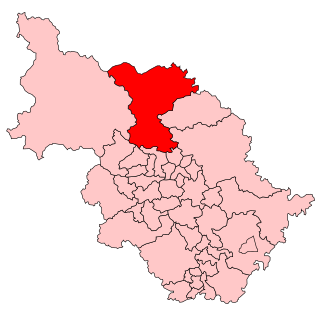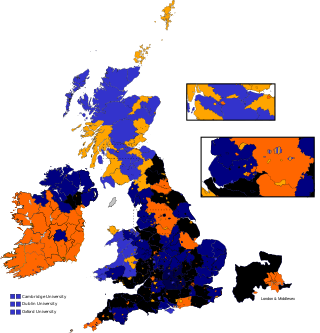The Representation of the People Act 1832 reformed the distribution of seats in England and Wales. It introduced the principle of splitting the shire counties into divisions and returning two Members for each division rather than for the whole county and it also reformed the parliamentary boroughs that were entitled to send Members to Parliament. Schedule A listed boroughs that were to be abolished and it included Newton. Schedule B listed boroughs to return a single Member to subsequent parliaments and Clitheroe was listed.
Schedules C and D of the act listed the newly created parliamentary boroughs. Those in schedule C were to return two members and these included Manchester, Bolton, Blackburn and Oldham in Lancashire. Those in schedule D were to become single seat boroughs and included Ashton-under-Lyne, Bury, Rochdale, Salford, and Warrington.
Schedule F of the act listed the counties to be divided into two divisions, both of which would return two Members. Lancashire was one of those listed. The Boundary Commission proposals that followed the act, published in 1832, made recommendations on the boundaries of the parliamentary boroughs and divisions of counties that had been listed in schedule F.9 These were then implemented by the Parliamentary Boundaries Act 1832.
The divisions of the county were based on the hundreds of Lancashire. The hundreds of Amounderness, Blackburn, Leyland and Lonsdale were allocated to the Northern division, and the Salford and West Derby hundreds were allocated to the Southern division. The boundary of the two divisions extended approximately from Southport to Wigan, north to Chorley, and then east, passing south of Haslingden, to the Bacup area.
The result of these changes meant the total parliamentary representation for Lancashire in the reformed House of Commons was 26, an increase of 12. Lancashire benefited more than any other county as a result of these reforms.
The constituency was abolished by the Redistribution of Seats Act 1885, being divided into five single member divisions of Barrow-in-Furness, Blackpool, Chorley, Lancaster, and North Lonsdale.

North Durham is a constituency represented in the House of Commons of the UK Parliament since 2024 by Luke Akehurst of the Labour Party.

Lancaster was a constituency of the House of Commons of the Parliament of England then of the Parliament of Great Britain from 1707 to 1800 and of the Parliament of the United Kingdom from 1801 to 1867, centred on the historic city of Lancaster in north-west England. It was represented by two Members of Parliament until the constituency was disenfranchised for corruption in 1867.
Sunderland was a borough constituency in the House of Commons of the United Kingdom, created by the Reform Act 1832 for the 1832 general election. It elected two Members of Parliament (MPs) by the bloc vote system of election. It was split into the single-member seats of Sunderland North and Sunderland South for the 1950 general election.
Bewdley was the name of a constituency of the House of Commons of the Parliament of the United Kingdom from 1605 until 1950. Until 1885 it was a parliamentary borough in Worcestershire, represented by one Member of Parliament; the name was then transferred to a county constituency from 1885 until 1950. Its MPs included the former Prime Minister Stanley Baldwin, who represented the seat from 1908 to 1937, and afterwards took the name of the constituency as part of his title when he was raised to the peerage.

Kidderminster was a parliamentary constituency in Worcestershire, represented in the House of Commons of the Parliament of the United Kingdom. It elected one Member of Parliament (MP) by the first past the post voting system.
The parliamentary borough of Finsbury was a constituency of the House of Commons of the UK Parliament from 1832 to 1885, and from 1918 to 1950. The constituency was first created in 1832 as one of seven two-seat "metropolis" parliamentary boroughs other than the two which already existed: Westminster and the City of London; the latter until 1885 retained an exceptional four seats. Finsbury was directly north of the City of London and was smaller than the Finsbury division of the Ossulstone hundred but took in land of Holborn division to its southwest in pre-introduction changes by Boundary Commissioners. It included Finsbury, Holborn, Moorfields, Clerkenwell, Islington, Stoke Newington and historic St Pancras. The 1918 constituency corresponded to the smaller Metropolitan Borough of Finsbury ; it was a seat, thus electing a single member, fulfilling a longstanding aim of Chartism which underscored the 1832 reforms.

Ripon was a constituency sending members to the House of Commons of England, Great Britain and the House of Commons of the Parliament of the United Kingdom until 1983, centred on the city of Ripon in North Yorkshire.
King's Lynn was a constituency in Norfolk which was represented continuously in the House of Commons of England from 1298 to 1707, in the House of Commons of Great Britain from 1707 to 1800, and in the House of Commons of the United Kingdom from 1801 until it was abolished for the February 1974 general election.

Lancashire was a county constituency of the House of Commons of the Parliament of England from 1290, then of the Parliament of Great Britain from 1707 to 1800, and of the Parliament of the United Kingdom from 1801 to 1832. It was represented by two Members of Parliament, traditionally known as Knights of the Shire until 1832.
Malton, also called New Malton, was a constituency of the House of Commons of the Parliament of England in 1295 and 1298, and again from 1640, then of the Parliament of Great Britain from 1707 to 1800 and of the Parliament of the United Kingdom from 1801 to 1885. It was represented by two Members of Parliament until 1868, among them the political philosopher Edmund Burke, and by one member from 1868 to 1885.

Leeds was a parliamentary borough covering the town of Leeds, in the West Riding of Yorkshire, England. It was represented in the House of Commons of the Parliament of the United Kingdom from 1832 to 1885.
Blackpool was a parliamentary constituency centred on the town of Blackpool in Lancashire. It returned one Member of Parliament (MP) to the House of Commons of the Parliament of the United Kingdom.

South Lancashire, formally called the Southern Division of Lancashire or Lancashire Southern, is a former county constituency of the South Lancashire area in England. It returned two Members of Parliament (MPs) to the British House of Commons from 1832 to 1861, and then from a very narrow reform of that year, three until it was further split in 1868.
North Northamptonshire was a county constituency in Northamptonshire, represented in the House of Commons of the Parliament of the United Kingdom. This constituency included the majority of the Soke of Peterborough, with the exception of the actual city of Peterborough itself, which was a borough constituency that returned its own MP.
South West Lancashire was a county constituency of the House of Commons of the Parliament of the United Kingdom. It was represented by two Members of Parliament. The constituency was created by the Reform Act of 1867 by the splitting of the South Lancashire constituency into new South-East and South-West divisions.
North East Lancashire was a county constituency of the House of Commons of the Parliament of the United Kingdom. The constituency was created by the Reform Act of 1867 and replaced the North Lancashire Parliamentary constituency, a county division with two seats.
Knaresborough was a parliamentary constituency which returned two Members of Parliament (MPs) to the Parliament of England, Parliament of Great Britain and the House of Commons of the Parliament of the United Kingdom until 1868, and then one MP until its abolition in 1885.

Tower Hamlets was a parliamentary borough (constituency) in Middlesex, England from 1832 to 1885. It elected two Members of Parliament (MPs) to the House of Commons of the Parliament of the United Kingdom. It was one of the first five of its type in the metropolitan area of London. It was enfranchised by the Reform Act 1832.
South Wiltshire, formally known as the Southern division of Wiltshire or Wiltshire Southern was a county constituency in the county of Wiltshire in South West England. It returned two Members of Parliament to the House of Commons of the Parliament of the United Kingdom, elected by the bloc vote system.

West Norfolk or Norfolk Western was a county constituency in the county of Norfolk, which returned two Members of Parliament (MPs) to the House of Commons of the Parliament of the United Kingdom, elected by the bloc vote system.







